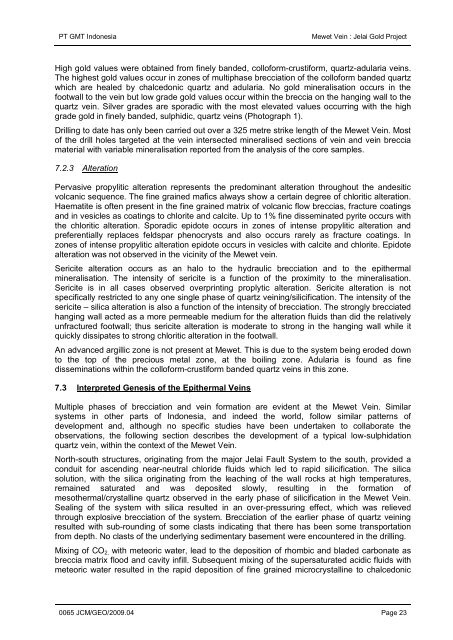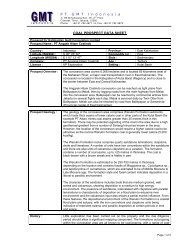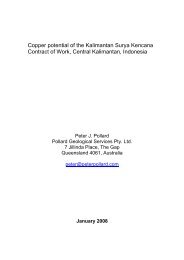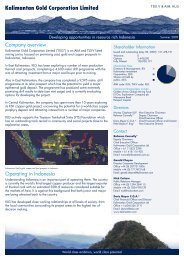Geology and mineralisation of the Mewet Vein, Jelai Gold Project ...
Geology and mineralisation of the Mewet Vein, Jelai Gold Project ...
Geology and mineralisation of the Mewet Vein, Jelai Gold Project ...
You also want an ePaper? Increase the reach of your titles
YUMPU automatically turns print PDFs into web optimized ePapers that Google loves.
PT GMT Indonesia<br />
<strong>Mewet</strong> <strong>Vein</strong> : <strong>Jelai</strong> <strong>Gold</strong> <strong>Project</strong><br />
High gold values were obtained from finely b<strong>and</strong>ed, coll<strong>of</strong>orm-crustiform, quartz-adularia veins.<br />
The highest gold values occur in zones <strong>of</strong> multiphase brecciation <strong>of</strong> <strong>the</strong> coll<strong>of</strong>orm b<strong>and</strong>ed quartz<br />
which are healed by chalcedonic quartz <strong>and</strong> adularia. No gold <strong>mineralisation</strong> occurs in <strong>the</strong><br />
footwall to <strong>the</strong> vein but low grade gold values occur within <strong>the</strong> breccia on <strong>the</strong> hanging wall to <strong>the</strong><br />
quartz vein. Silver grades are sporadic with <strong>the</strong> most elevated values occurring with <strong>the</strong> high<br />
grade gold in finely b<strong>and</strong>ed, sulphidic, quartz veins (Photograph 1).<br />
Drilling to date has only been carried out over a 325 metre strike length <strong>of</strong> <strong>the</strong> <strong>Mewet</strong> <strong>Vein</strong>. Most<br />
<strong>of</strong> <strong>the</strong> drill holes targeted at <strong>the</strong> vein intersected mineralised sections <strong>of</strong> vein <strong>and</strong> vein breccia<br />
material with variable <strong>mineralisation</strong> reported from <strong>the</strong> analysis <strong>of</strong> <strong>the</strong> core samples.<br />
7.2.3<br />
Alteration<br />
Pervasive propylitic alteration represents <strong>the</strong> predominant alteration throughout <strong>the</strong> <strong>and</strong>esitic<br />
volcanic sequence. The fine grained mafics always show a certain degree <strong>of</strong> chloritic alteration.<br />
Haematite is <strong>of</strong>ten present in <strong>the</strong> fine grained matrix <strong>of</strong> volcanic flow breccias, fracture coatings<br />
<strong>and</strong> in vesicles as coatings to chlorite <strong>and</strong> calcite. Up to 1% fine disseminated pyrite occurs with<br />
<strong>the</strong> chloritic alteration. Sporadic epidote occurs in zones <strong>of</strong> intense propylitic alteration <strong>and</strong><br />
preferentially replaces feldspar phenocrysts <strong>and</strong> also occurs rarely as fracture coatings. In<br />
zones <strong>of</strong> intense propylitic alteration epidote occurs in vesicles with calcite <strong>and</strong> chlorite. Epidote<br />
alteration was not observed in <strong>the</strong> vicinity <strong>of</strong> <strong>the</strong> <strong>Mewet</strong> vein.<br />
Sericite alteration occurs as an halo to <strong>the</strong> hydraulic brecciation <strong>and</strong> to <strong>the</strong> epi<strong>the</strong>rmal<br />
<strong>mineralisation</strong>. The intensity <strong>of</strong> sericite is a function <strong>of</strong> <strong>the</strong> proximity to <strong>the</strong> <strong>mineralisation</strong>.<br />
Sericite is in all cases observed overprinting proplytic alteration. Sericite alteration is not<br />
specifically restricted to any one single phase <strong>of</strong> quartz veining/silicification. The intensity <strong>of</strong> <strong>the</strong><br />
sericite – silica alteration is also a function <strong>of</strong> <strong>the</strong> intensity <strong>of</strong> brecciation. The strongly brecciated<br />
hanging wall acted as a more permeable medium for <strong>the</strong> alteration fluids than did <strong>the</strong> relatively<br />
unfractured footwall; thus sericite alteration is moderate to strong in <strong>the</strong> hanging wall while it<br />
quickly dissipates to strong chloritic alteration in <strong>the</strong> footwall.<br />
An advanced argillic zone is not present at <strong>Mewet</strong>. This is due to <strong>the</strong> system being eroded down<br />
to <strong>the</strong> top <strong>of</strong> <strong>the</strong> precious metal zone, at <strong>the</strong> boiling zone. Adularia is found as fine<br />
disseminations within <strong>the</strong> coll<strong>of</strong>orm-crustiform b<strong>and</strong>ed quartz veins in this zone.<br />
7.3<br />
Interpreted Genesis <strong>of</strong> <strong>the</strong> Epi<strong>the</strong>rmal <strong>Vein</strong>s<br />
Multiple phases <strong>of</strong> brecciation <strong>and</strong> vein formation are evident at <strong>the</strong> <strong>Mewet</strong> <strong>Vein</strong>. Similar<br />
systems in o<strong>the</strong>r parts <strong>of</strong> Indonesia, <strong>and</strong> indeed <strong>the</strong> world, follow similar patterns <strong>of</strong><br />
development <strong>and</strong>, although no specific studies have been undertaken to collaborate <strong>the</strong><br />
observations, <strong>the</strong> following section describes <strong>the</strong> development <strong>of</strong> a typical low-sulphidation<br />
quartz vein, within <strong>the</strong> context <strong>of</strong> <strong>the</strong> <strong>Mewet</strong> <strong>Vein</strong>.<br />
North-south structures, originating from <strong>the</strong> major <strong>Jelai</strong> Fault System to <strong>the</strong> south, provided a<br />
conduit for ascending near-neutral chloride fluids which led to rapid silicification. The silica<br />
solution, with <strong>the</strong> silica originating from <strong>the</strong> leaching <strong>of</strong> <strong>the</strong> wall rocks at high temperatures,<br />
remained saturated <strong>and</strong> was deposited slowly, resulting in <strong>the</strong> formation <strong>of</strong><br />
meso<strong>the</strong>rmal/crystalline quartz observed in <strong>the</strong> early phase <strong>of</strong> silicification in <strong>the</strong> <strong>Mewet</strong> <strong>Vein</strong>.<br />
Sealing <strong>of</strong> <strong>the</strong> system with silica resulted in an over-pressuring effect, which was relieved<br />
through explosive brecciation <strong>of</strong> <strong>the</strong> system. Brecciation <strong>of</strong> <strong>the</strong> earlier phase <strong>of</strong> quartz veining<br />
resulted with sub-rounding <strong>of</strong> some clasts indicating that <strong>the</strong>re has been some transportation<br />
from depth. No clasts <strong>of</strong> <strong>the</strong> underlying sedimentary basement were encountered in <strong>the</strong> drilling.<br />
Mixing <strong>of</strong> CO 2, with meteoric water, lead to <strong>the</strong> deposition <strong>of</strong> rhombic <strong>and</strong> bladed carbonate as<br />
breccia matrix flood <strong>and</strong> cavity infill. Subsequent mixing <strong>of</strong> <strong>the</strong> supersaturated acidic fluids with<br />
meteoric water resulted in <strong>the</strong> rapid deposition <strong>of</strong> fine grained microcrystalline to chalcedonic<br />
0065 JCM/GEO/2009.04 Page 23










